Using a sales follow-up survey template offers several benefits: Standardized data collection: Templates ensure consistency in the questions asked, making it easier to compare and analyze responses over time. Time-saving: Pre-designed templates save time in creating and distributing surveys, allowing sales teams to focus on other tasks. Improved customer experience: Follow-up surveys show customers that their feedback is valued, enhancing their overall experience with the company.

When choosing a sales follow-up survey template, consider the following factors: Target audience: Identify the specific group of customers you want to survey, such as leads, existing customers, or lost opportunities. Survey goals: Determine the key information you want to gather, such as customer satisfaction, product feedback, or purchase intent. Distribution channel: Decide how you will distribute the survey, such as email, phone, or social media.
Key Components of Sales Follow-Up Survey Template
An effective sales follow-up survey template should include the following key components:
1: Introduction and Purpose
Begin the survey with a brief introduction that explains the purpose of the survey and thanks the customer for their time. Clearly state the specific topic or area you are seeking feedback on.
2: Customer Satisfaction Questions
Include questions that gauge the customer’s overall satisfaction with their recent sales interaction. This could include questions about the salesperson’s knowledge and helpfulness, the product or service itself, and the overall sales process.
3: Specific Feedback Questions
Ask specific questions about areas where you want to gather detailed feedback. For example, if you are launching a new product, you could ask customers to rate different features or provide suggestions for improvement.
4: Open-Ended Questions
Provide opportunities for customers to provide open-ended feedback. This allows them to express their thoughts and opinions in their own words, giving you valuable insights that may not be captured by closed-ended questions.
5: Demographic Questions
Optional demographic questions can help you segment your responses and identify trends based on factors such as industry, company size, or job title.
6: Call to Action
End the survey with a clear call to action. Let customers know what you plan to do with their feedback and how they can expect to hear back from you.
Summary
By including these key components in your sales follow-up survey template, you can gather valuable customer feedback that can help you improve your sales process, products or services, and overall customer experience.
How to Create a Sales Follow-Up Survey Template
Creating an effective sales follow-up survey template is crucial for gathering valuable customer feedback. Here are the steps to follow:
1: Define Your Goals
Clearly define the objectives of your survey. Determine what specific information you want to collect from customers, such as their satisfaction levels, feedback on products or services, or suggestions for improvement.
2: Choose the Right Questions
Select a mix of closed-ended and open-ended questions to gather both quantitative and qualitative data. Closed-ended questions provide structured options for customers to choose from, while open-ended questions allow them to provide detailed feedback in their own words.
3: Keep it Concise
Customers are more likely to complete surveys that are brief and to the point. Focus on asking essential questions that directly relate to your survey goals. Avoid unnecessary or repetitive questions.
4: Use a Clear and Professional Design
Design your survey template with a professional and user-friendly layout. Use clear fonts, appropriate spacing, and logical question flow. Ensure the survey is mobile-responsive for easy access on any device.
5: Personalize the Survey
Including personalized elements, such as addressing customers by name or referencing their specific purchase or interaction, can make your survey feel more relevant and engaging.
6: Test and Refine
Before distributing your survey widely, test it with a small group of trusted individuals to identify any errors or areas for improvement. Based on their feedback, refine your survey to enhance its effectiveness.
Summary
Creating an effective sales follow-up survey template involves defining your goals, choosing the right questions, keeping it concise, using a clear design, personalizing the experience, and testing and refining the survey. By following these steps, you can develop a survey that gathers valuable customer feedback to improve your sales process and customer relationships.
In conclusion, a well-crafted sales follow-up survey template is an invaluable tool for businesses to gather customer feedback, improve their sales process, and build stronger customer relationships. By incorporating the key components outlined in this article, businesses can create surveys that effectively capture customer satisfaction levels, specific feedback, and valuable insights. The use of closed-ended and open-ended questions, a concise and professional design, and personalized elements can enhance the effectiveness and response rates of sales follow-up surveys.
Investing in a comprehensive sales follow-up survey template demonstrates a commitment to customer satisfaction and continuous improvement. By actively seeking and analyzing customer feedback, businesses can identify areas for improvement, address customer concerns, and ultimately drive business growth and success.

